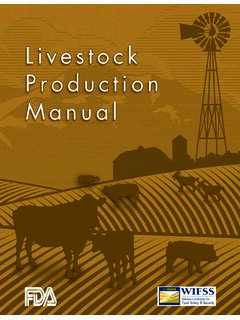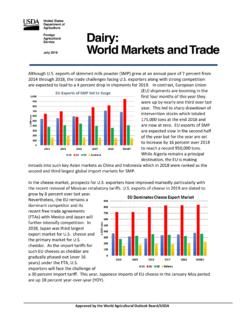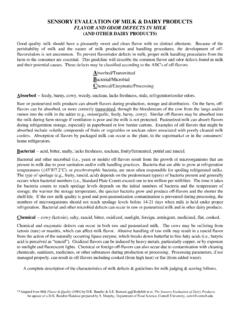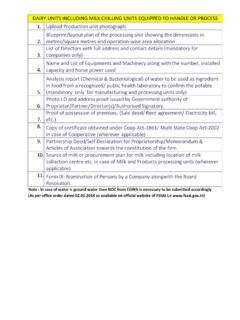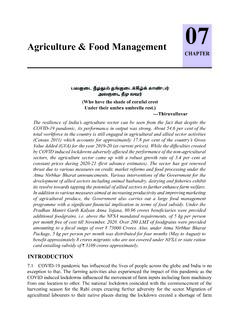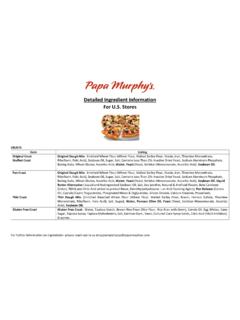Transcription of INTRODUCTION TO CLEANER PRODUCTION (CP) CONCEPTS …
1 INTRODUCTION TO INTRODUCTION TO CLEANER PRODUCTION ( CLEANER PRODUCTION (CPCP))CONCEPTSCONCEPTSAND PRACTICEAND PRACTICES ponsored by UNEP, Division of Technology, Industry, and Economics Prepared by the Institute of Environmental Engineering (APINI) Kaunas University of Technology, LithuaniaTeam for CP success Managers, engineersand finance people in industry andcommerce, in particular those responsible for business strategy, product development, plant operations and finance Government officials, both central and regional, who play an important role in promoting CP Media representatives who play an important role in disseminating information on good environmental practiceWhat is waste?There are literally hundreds words for different types of waste: greenhouse loss hidden losses leakage non-conforming material overfill packaging process loss rework second quality stock loss washingsand etc.
2 Allowance BOD broke contaminated solids core loss customer returns damage drainings dust effluent evaporation furnace lossWaste is waste what ever you call it :take the opportunity to cut waste and increase profits!!!!Where are you now? Onlyachange in technology would eliminate waste completely Weareoptimising our processes and achieving bigcostreductions Waste is coming down as we change the way we work We have identified our waste and monitoringit We plantoreduce waste Waste iscostand regulatory issue Waste is only disposal issue Waste is not an issuePassive environmental Passive environmental strategiesstrategiesDilute & disperseReactive environmental Reactive environmental strategies: strategies: endend--ofof--pipe approachespipe approachesReactive environmental Reactive environmental strategiesstrategiesOn -site recyclingProactive environmental Proactive environmental strategies: strategies: CLEANER ProductionCleaner ProductionPrevention of Waste Prevention of Waste generation:generation.
3 -Good housekeeping-Input substitution-Better process control-Equipment modification-Technology change-Product modification-Efficient use of energyresources-On-site recovery/reuseCleaner PRODUCTION DefinitionCleaner Productionis a PreventiveIntegratedContinuousStrategyfo r modifyingProcessesProductsServicesEnviro nmental Performanceand Reduces Coststo enhanceEfficiencywhich improvesPrincipleSubstitutionSourceReduc tionDesign forEnvironment EnergyConservationReductionOf RisksCompetitiveAdvantage12 Properly implementedCP :always reduces long-term liabilities which companies can face many years after pollution has been generated or disposed at a given siteProperly implementedCP :usually increases profitability lowers PRODUCTION costs enhances productivity provides a rapid return on any capital or operating investments required increases product yield leads to the more efficient use of energy and raw materialsProperly implementedCP :usually(continuation) results in improved product quality increases staff motivation relies on active worker participation in idea generation and implementation reduces consumer risks reduces the risk of environmental accidents is supported by employees, local communities, customers and the publicProperly implementedCP.
4 Often avoids regulatory compliance costs leads to insurance savings provides enhanced access to capital from financial institutions and lenders is fast and easy to implement requires little capital investmentHow CP could be applied in practice? CLEANER PRODUCTION practices1. Good Housekeepingtake appropriate managerial and operationalactions to prevent:-leaks-spills-to enforce existing operational instructionsCleaner PRODUCTION practices2. Input Substitutionsubstitute input materials-by less toxic-or by renewable materials -or by adjunct materials which have a longer service life-time in productionCleaner PRODUCTION practices3. Better Process Controlmodify:-operational procedures-equipment instructionsand process record keeping in order to run the processes more efficiently and at lower waste and emission generation ratesCleaner PRODUCTION practices4.
5 Equipment Modificationmodify the existing PRODUCTION equipment and utilities in order:-run the processes at higher efficiency-lower waste and emission generation ratesCleaner PRODUCTION practices5. Technology Changereplace of:-the technology-processing sequence-synthesis pathway in order to minimise waste and emission generation during productionCleaner PRODUCTION practices6. On-site Recovery/Reuse-reuse of the wasted materials in the same process for another useful application within the companyCleaner PRODUCTION practices7. Product Modificationmodify the product characteristics in order:-to minimise the environmental impacts of the product during or after its use (disposal)-to minimise the environmental impacts of its productionCleaner PRODUCTION practices8. Using Energy EfficientlyReduce the environmental impact from energy use by:-improved energy efficiency-by using energy from renewable sourcesCP versusEnd-of-PipeapproachCleaner ProductionCleaner ProductionContinuous improvementProgress towards use of closed loop or continuous cycle processesEveryone in the community has a role to play.
6 Partnerships are essential Active anticipation and avoidance of pollution and wasteElimination of environmental problems at their sourceInvolves new practices, attitudes and management techniques and stimulates technical advancesPollution Control and Waste Pollution Control and Waste ManagementManagementOne-off solutions to individual problemsProcesses result in waste materials for disposal a pipeline with resources in and wastes outSolutions are developed by experts often in isolationReactive responses to pollution and waste after they are createdPollutants are controlled by waste treatment equipment and methodsRelies mainly on technical improvements to existing technologiesWhat Are the Benefits of What Are the Benefits of CLEANER PRODUCTION ? CLEANER PRODUCTION ?Improving Improving environmental situationenvironmental situationIncreasing Increasing economical benefitseconomical benefitsIncreasing Increasing productivityproductivityGaining Gaining competitive competitive advantageadvantageContinuous Continuous environmental environmental improvementimprovementWhat is not CP?
7 OffOff--site recyclingsite recycling Transferring hazardous Transferring hazardous wasteswastes Waste treatment Waste treatment Concentrating hazardous Concentrating hazardous or toxic constituents to or toxic constituents to reduce volume reduce volume Diluting constituents to Diluting constituents to reduce hazard or toxicity reduce hazard or toxicity CPbarriersInternal to the companies:-Lack of information and expertise-Low environmental awareness-Competing business priorities, in particular, the pressure for a short term profits-Financial obstacles-Lack of communication in firms-Middle management inertia-Labour force obstacles-Difficulty in accessing CLEANER technologies-Difficulty in accessing external financeCPbarriersExternal to the companies:The failure of existing regulatory approachesCPmotivators and driversInternal to the companies:-Improvements in productivity-Environmental management systems and continuous improvement-Environmental leadership-Corporate environmental reports-Environmental accountingCPmotivators and driversExternal to the companies.
8 -Innovative regulation-Economic incentives-Education and training-Buyer supplier relations-Soft loans from Financial institutions-Community involvement-International trade incentivesCP attacks the problem at several levels at once, INTRODUCTION of a industry/plant level program requires-the commitment of top management-a systematic approach to CP in all aspects of the PRODUCTION processesMarketingTop management commitmentPre-assessmentCP policy declarationThe continuous CP loopAssessmentStart CP projectProject organisationPP optionsFeasibility analysisAssessment reportProject implementationMeasure progressFinal reportTop Management reviewsCP management system48 How can governments promoteCP? Applying regulations Using economic instruments Providing support measures Obtaining external assistanceCP applicability for local governments Corporate decision-making Local environmental management strategies Community and industry partnerships Sustainable economic development Public environmental education Specific local environmental problems Local environmental monitoringCPand financial institutionsEnvironmental evaluation will assist financial institution s staff to.
9 Avoid financing activities included in their exclusion list identify the relative environmental risks level and assess client's ability to manage them understand the financial institution s exposure to environmental risks and liabilities and to respond adequately monitor the risks of the transactions and respond to changes in the bank s exposure to those risks evaluate risks and potential liabilities in foreclosure or re-structuring activitiesEnvironmental Assessment of a ProjectLoan ApplicationEnvironmental assessment of the projectAppraisal Cash flow Financial position Management Adequacy of security Loan structure Sectoraloutlook CompetitivenessBased on CLEANER PRODUCTION ConceptBased on Pollution Control ConceptLoanproposalAgreementMonitoring and ReportsEnvironmental Due Diligence Screening Appraisal PreventiveRiskmanagement MonitoringEnvironmental performance improvedEnvironmetal impact of secondary pollution shouldbeanalisedEnvironmental performance reduced++(-)+--+(-)+(-)+(-)Progress52 Factors Affecting Exposure to Environmentally-derived Risks The nature of environmental risks inherent in business activity of the client The size and term of, and the security for, the transaction The client s ability and commitment to adequately manage these risksIf CP project is presented to financial institution, it should be clear that company already undertook voluntaryactions aimed at.
10 Rationalising the use of raw materials, water and energy inputs, reducing the loss of valuable material inputs and therefore reducing operational costs reducing the volume and/or toxicity of waste, wastewater and emissions related to PRODUCTION improving working conditions and occupational safety in a company making organisational improvements improving environmental performance by the implementation of no-cost and low-cost measures from the company s funds reusing and/or recycling the maximum of primary inputs and packaging materialsOther Business Activities the Financial Institutions Should Be Aware Trade finance Retail banking Equity investmentsEnvironmental Investment Opportunities loans to enterprises to finance required or desired investments in technologies resulting in direct and indirect environmental benefits loans to municipalities to finance investments in environmental infrastructure loan guarantees to both










